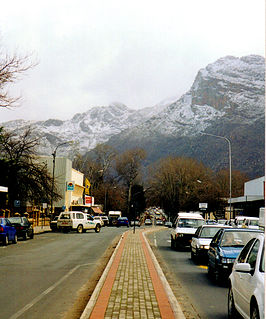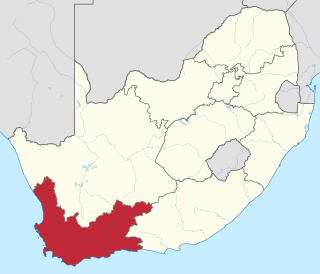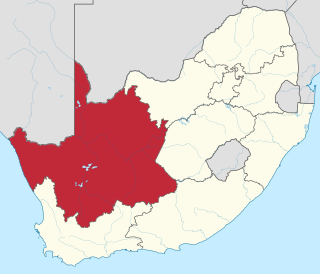| Oudebaaskraal Dam | |
|---|---|
| Official name | Oudebaaskraal Dam |
| Country | South Africa |
| Location | Ceres, Western Cape |
| Coordinates | 32°23′27.25″S19°53′32.65″E / 32.3909028°S 19.8924028°E Coordinates: 32°23′27.25″S19°53′32.65″E / 32.3909028°S 19.8924028°E |
| Purpose | Irrigation |
| Opening date | 1969 |
| Owner(s) | Department of Water Affairs |
| Dam and spillways | |
| Type of dam | Earth fill dam |
| Impounds | Tankwa River |
| Height | 21 metres (69 ft) |
| Length | 1,200 metres (3,900 ft) |
| Reservoir | |
| Creates | Oudebaaskraal Dam Reservoir |
| Total capacity | 34,000,000 cubic metres (1.2×109 cu ft) |
| Catchment area | 800 hectares (2,000 acres) |
Oudebaaskraal Dam is an earth-fill type dam located on the Tankwa River near Ceres, Western Cape, South Africa. It was established in 1969 and serves mainly for irrigation purposes. The hazard potential of the dam has been ranked significant (2).

Ceres is the administrative centre and largest town of the Witzenberg Local Municipality in the Western Cape Province of South Africa. Ceres serves as a regional centre for the surrounding towns of Wolseley, Tulbagh, Op-die-Berg and Prince Alfred Hamlet. It is situated in the Warmbokkeveld Valley about 170 km north-east of Cape Town. Ceres is located at the north-eastern entrance to Michell's Pass and was the old route north between Cape Town and Johannesburg, which was later replaced by the N1 highway, which traverses the Breede River Valley to the south.

The Western Cape is a province of South Africa, situated on the south-western coast of the country. It is the fourth largest of the nine provinces with an area of 129,449 square kilometres (49,981 sq mi), and the third most populous, with an estimated 6.6 million inhabitants in 2018. About two-thirds of these inhabitants live in the metropolitan area of Cape Town, which is also the provincial capital. The Western Cape was created in 1994 from part of the former Cape Province.

South Africa, officially the Republic of South Africa (RSA), is the southernmost country in Africa. It is bounded to the south by 2,798 kilometres (1,739 mi) of coastline of Southern Africa stretching along the South Atlantic and Indian Oceans; to the north by the neighbouring countries of Namibia, Botswana, and Zimbabwe; and to the east and northeast by Mozambique and Eswatini (Swaziland); and it surrounds the enclaved country of Lesotho. South Africa is the largest country in Southern Africa and the 25th-largest country in the world by land area and, with over 57 million people, is the world's 24th-most populous nation. It is the southernmost country on the mainland of the Old World or the Eastern Hemisphere. About 80 percent of South Africans are of Sub-Saharan African ancestry, divided among a variety of ethnic groups speaking different African languages, nine of which have official status. The remaining population consists of Africa's largest communities of European (White), Asian (Indian), and multiracial (Coloured) ancestry.
Oudebaaskraal Dam is next to Wadrif and is located in Cape Winelands District Municipality, Western Cape, South Africa. Oudebaaskraal Dam has a length of 14.34 kilometres. [1]
A game drive in the stony desert area around the Oudebaaskraal Dam is probably the best chance of spotting some of the animals that have been reintroduced into the Tankwa Karoo National Park, like gemsbok, springbok, hartebeest and Cape mountain zebra. Perhaps even a bat-eared fox and a tortoise or two. [2] Hundreds of Pink Flamingos can be spotted there at certain times, and the areas of the dam which are covered in algae have a kelp type smell similar to the ocean.

Tankwa Karoo National Park is a national park in South Africa. The park lies about 70 km due west of Sutherland near the border of the Northern Cape and Western Cape, in one of the most arid regions of South Africa, with areas receiving less than 100 mm of average annual precipitation, moisture-bearing clouds from the Atlantic Ocean being largely stopped by the Cederberg mountains. Other low areas receive little more, as the Roodewerf station with 180 mm of mean annual rainfall. In the hottest areas of the park, the mean maximum temperature in January is 38.9 °C, and in July the mean minimum temperature ranges from about 5 to 7 °C. Before this Park's proclamation, the only protected area of Succulent Karoo was the 2 square kilometre patch of the Gamkaberg Nature Reserve. Succulent Karoo has, together with the Cape Floral Kingdom, been declared a Biodiversity Hotspot by Conservation International.

The gemsbok, gemsbuck or South African oryx is a large antelope in the genus Oryx. It is native to the arid regions of Southern Africa, such as the Kalahari Desert. Some authorities formerly included the East African oryx as a subspecies.














